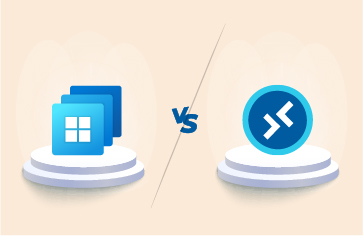AVD (Azure Virtual Desktop) has grown in popularity and for many reasons many organizations are choosing to consume AVD via a specialist Managed Service Provider (MSP). For the MSPs offering AVD, monitoring and troubleshooting AVD especially for multi-tenant environments is challenging and involves significant, costly and skilled effort using native tools such as Azure Insights or Azure Monitor.
For several years, eG Enterprise has offered digital workspace and DaaS monitoring and root-cause identification tools to MSPs for technologies such as Citrix, VMware, Amazon WorkSpaces / AppStream 2.0, Microsoft RDP and more. The proven and hardened architecture and multi-tenant features for AVD and other workspaces remain the leading monitoring solution for MSPs delivering DaaS, VDI and other services. Hundreds of MSPs use eG Enterprise to grow their business and revenues, ensuring performance and reliability of their services, and ultimately delivering on their promises to customers.
Today I’ll cover 10 key features on why MSPs choose eG Enterprise as their AVD monitoring platform:
- Fully Multi-Tenant Architecture and Multi-Tenancy
- Comprehensive Specialist Monitoring and Troubleshooting for AVD Desktops and Apps
- Integrated Azure AD / Entra ID Monitoring
- Dedicated MSP Partner Program, Licensing and Pricing
- Full Range of Synthetic Testing Tools
- Protects MSPs’ Helpdesks from Azure, AVD, Microsoft 365 and Cloud Service Outages
- Secure Universal Agent and Operator Technologies Designed for Automation
and IaC Workflows - AIOps Capabilities
- ITSM and Helpdesk Tool Integrations
- Rich Analytics and Reporting Capabilities allow MSPs to Demonstrate Value to Customers
10 Reasons why MSPs choose eG Enterprise for
monitoring AVD
1. Fully Multi-Tenant Architecture and Multi-Tenancy Features
Many of our MSP partners chose eG Enterprise for its secure and granular role-based multi-tenancy support. The MSP does not have to configure and maintain one instance of eG Enterprise for each customer. Instead, they can deploy one eG Enterprise instance to which agent-based and agentless monitoring provides deep diagnostics and analytics for multiple customers (tenants).
The distinct advantage of multi-tenant configurations for MSPs is that they can use a single unified interface to monitor multiple customers. MSP admins do not have to shift through multiple consoles, one for each customer. Additionally, by amortizing hardware, software, and storage costs across customers, the MSP can drive further cost savings, which in turn improves competitive advantage for themselves and their customers.
Details of eG Enterprise features, including tenant self-service features, designed to support for MSPs are well covered in these articles and should help you evaluate our solution compared to others:
- Learn about our dedicated MSP features in this article, Multi-Tenant MSP Monitoring | eG Innovations.
- More information and an overview of MSPs’ needs is provided in, What is multi-tenancy? Multi-tenancy for MSPs Explained. | eG Innovations.
2. Comprehensive Specialist Monitoring and Troubleshooting for MSPs Monitoring AVD Desktops and Apps
The end-to-end monitoring for AVD provided by eG Enterprise has been designed to eliminate blind spots for MSPs and cater to their service desk and capacity management needs, whilst keeping control on costs.
We have built a comprehensive observability solution for Azure Virtual Desktop (AVD) that requires no scripting or specialist AVD knowledge to leverage. Benefits include:
- Data sampling and retention are controlled by you, predictable costs mean you can avoid the complexity and often high costs of native Azure Monitor
- Out-of-the-box live and historical reporting with hundreds of pre-built and configurable reports plus a GUI tool to build custom reports
- A range of great user experience dashboards and drilldowns designed for troubleshooting DEX (Digital Employee Experience)
- Capacity planning and trending tools to ensure MSPs can right-size to minimize costs without compromising on application performance, availability, or user experience.
You can learn more:
- Troubleshooting Azure Virtual Desktop (AVD) Issues through Logon and Beyond | eG Innovations
- Reduce Azure costs by finding unused and wasted resources
- Azure Virtual Desktop Monitoring – Solution Brief (eginnovations.com)
- Estimating Azure Monitor Cost for AVD Monitoring (eginnovations.com)
3. Integrated Azure AD / Entra ID Monitoring
 This summer, Sherweb published a guide for their MSP partners on Azure AD monitoring. Sherweb partner with over 7000+ MSPs partners, they really understand the AVD challenges and needs for MSPs. They covered the importance of monitoring Azure AD (now Entra ID) for MSP efficiency and security, see: What MSPs should know about Azure AD Monitoring | Sherweb.
This summer, Sherweb published a guide for their MSP partners on Azure AD monitoring. Sherweb partner with over 7000+ MSPs partners, they really understand the AVD challenges and needs for MSPs. They covered the importance of monitoring Azure AD (now Entra ID) for MSP efficiency and security, see: What MSPs should know about Azure AD Monitoring | Sherweb.
Sherweb described how to leverage native tools such as Azure Monitor to perform critical Azure AD monitoring. Another article by Azure veteran Alan Kinane covers some details of what this would involve an MSP doing, see: MSP: The well-tempered Azure tenant – Part 5 (azurealan.ie). Kinane’s article reveals that the Azure Monitor still requires significant manual configuration or tooling to achieve even basic levels of monitoring and alerting.
For many modern MSPs, especially those looking to proactively monitor logs and metrics and automate setup across customers – the comprehensive out-of-the-box Azure AD monitoring provided by eG Enterprise is a cost-effective alternative to the manual effort required to leverage Azure Monitor, see: How to monitor Azure AD Step by Step | eG Innovations.
4. Dedicated MSP Partner Program, Licensing and Pricing
eG Enterprise’s flexible, pay-per-use billing model (monthly and by usage billing, and tracking, allows MSPs to only pay for their usage of eG Enterprise on timescales that suit their cashflow model and charge their customers accordingly).
Many of our MSP customers chose to white label the monitoring service and displaying their own MSP’s brand.

You can learn more about our MSP partner program, here: Managed Services | Monitoring for MSPs.
5. Full Range of Synthetic Testing Tools for MSPs Monitoring AVD
eG Enterprise offers a full range of synthetic testing tools for AVD, including AVD logon simulators, full client session simulators, web app simulators and more. MSPs can proactively probe their services even when no real users are accessing systems to ensure they discover any issues rather than their customers. Read more: Synthetic Monitoring of Microsoft Azure DaaS | eG Innovations.
6. Protects MSPs’ Helpdesks from Azure, AVD, Microsoft 365 and Cloud Service Outages
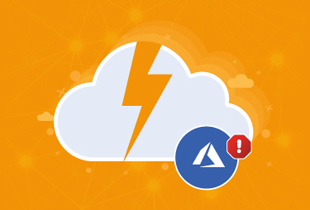 For MSPs delivering Azure based services such as AVD, Azure service outages can be painful. The customers call the MSPs when their desktops are unavailable and if Azure is down, so too may be the MSPs access to native Azure Monitor monitoring or even email if reliant on Microsoft 365. Using eG Enterprise as a cloud agnostic external solution allows MSPs monitoring AVD to protect and retain their IT Ops visibility on Azure services. This allows MSPs monitoring AVD to demonstrate when fault lies in the cloud supplier and provide customers with clear data and proof or even proactively notify customers of Azure issues to avoid unnecessary service desk tickets. See: How to Protect your IT Ops from Cloud Outages and Is M365 Down? – Proactive Alerting of a Microsoft Azure Outage (eginnovations.com).
For MSPs delivering Azure based services such as AVD, Azure service outages can be painful. The customers call the MSPs when their desktops are unavailable and if Azure is down, so too may be the MSPs access to native Azure Monitor monitoring or even email if reliant on Microsoft 365. Using eG Enterprise as a cloud agnostic external solution allows MSPs monitoring AVD to protect and retain their IT Ops visibility on Azure services. This allows MSPs monitoring AVD to demonstrate when fault lies in the cloud supplier and provide customers with clear data and proof or even proactively notify customers of Azure issues to avoid unnecessary service desk tickets. See: How to Protect your IT Ops from Cloud Outages and Is M365 Down? – Proactive Alerting of a Microsoft Azure Outage (eginnovations.com).
7. Secure Universal Agent and Operator Technologies Designed for Automation and IaC Workflows
eG Enterprise is designed to be deployed automatically within complex systems that auto-scale up and down whether that be DaaS or containerized microservice architectures. As such the secure eG Agent architecture is designed to be deployed without compromising security. Moreover, eG Enterprise is designed to be deployed within the automated workflows leveraged by modern MSPs, whether that be by scripts, APIs, Terraform, Ansible, Azure Resource Manager (ARM) templates, Azure DevOps, Bicep and so on, or via third-party management and orchestration tools such as Nerdio.
Read more:
- How to Monitor IT Infrastructure when adopting IaC for VDI and Digital Workspaces | eG Innovations
- Azure automation tools | eG Innovations
- Using Nerdio Manager to Deploy eG Enterprise for AVD Monitoring (eginnovations.com)
Rich APIs and PowerShell scripting capabilities allow sophisticated MSPs to automate further.
8. AIOps Capabilities
AIOps observability and monitoring capabilities are becoming essential to modern MSPs looking to operate efficiently and to be able to scale. Unlike most legacy EUC monitoring tools used in traditional on-prem VDI environments, eG Enterprise is fully featured AIOps platform offering APM (Application Performance Monitoring) capabilities. The automation features delivered by AIOps allow MSPs monitoring AVD to the manual effort and limitations of native cloud tooling.

There is plenty of information on this trend and why MSPs prefer AIOps enabled monitoring, see:
- MSPs Look For Built-in Monitoring With AIOps – | ChannelE2E cites some interesting recent survey data that found Intelligent alerting is the No. 1 use case for AIOps today for both enterprises (70%) and MSPs (66%).
- AIOps Key to MSP Survival in the AI Revolution — Redmond Channel Partner (rcpmag.com) focuses on MSPs need identify anomalies – ”you need to identify unusual patterns in the data, and do it in real time — not possible for humans”.
- Survey sees larger MSPs embracing AIOps (smartermsp.com) reports more survey data on the usage by MSPs of key AIOps features including intelligent alerting, incident auto-remediation, root cause analysis and anomaly/threat detection.
- How is AIOps Empowering Managed Services? | by BuildPiper | BuildPiper | Medium a nice summary of the benefits of AIOps powered monitoring by Ruchita Varma from a DevSecOps perspective.
We’ve a free eBook available that covers the essentials of AIOps monitoring, see: AIOps Solutions and Strategies for IT Management. It’s a great place to learn how AIOps features automate alerting set up and avoid alarm storms in production.
You can learn more about how modern AIOps tools compare to RMM tools, see: Modern MSP Tools vs. RMM Tools.
9. ITSM and Helpdesk Tool Integrations
eG Enterprise allows the MSP to offer helpdesk ticketing in the systems of choice of the tenant / customer whether that is ServiceNow, PagerDuty, MS teams, or others. Details are given in: Integration with multiple ITSM tools at the same time and Service and Help Desk Automation Strategies.
10. Rich Analytics and Reporting Capabilities allow MSPs to Demonstrate Value to Customers
Reports provide AVD administrators with all the details they need for compliance reporting and infrastructure optimization.
- Report on who logged in, at what times, what applications they accessed, what resources they used and how their digital employee experience (DEX) was. Track active/idle times to report time periods when the user was not active.
- Monitor all aspects of resource usage on the session hosts. Identify bottlenecks including under-sized hosts, applications with resource usage issues, and users generating unusual activity on the shared hosts.
- Get insights to right-size and optimize the infrastructure to deliver better performance and to enhance the infrastructure to accommodate additional users.
eG Innovations
eG Enterprise is an Observability solution for Modern IT. Monitor digital workspaces,
web applications, SaaS services, cloud and containers from a single pane of glass.
Learn more:
- Learn more our support for digital workspace monitoring, whether that be physical endpoints, DaaS or VDI, see: Best Digital Workspace Monitoring Tools | eG Innovations
- Read a case study about one of our MSP partners: Spadafy leverages eG Enterprise to deliver secure VDI and professional services to healthcare providers – Case Study | eG Innovations


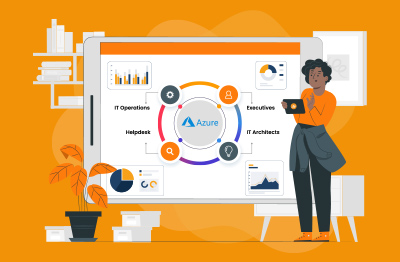
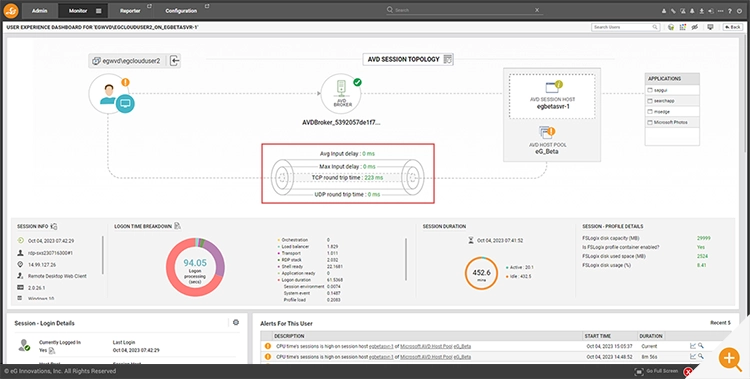
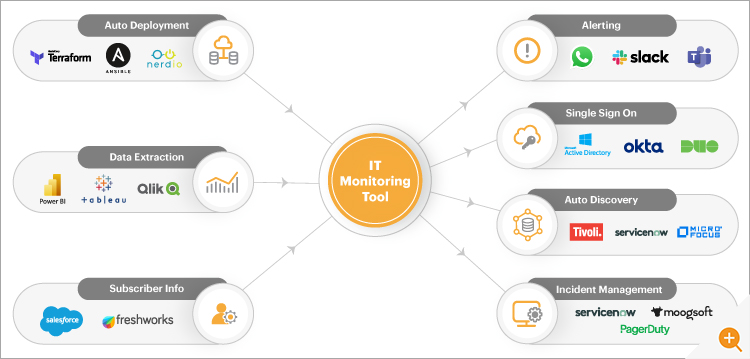
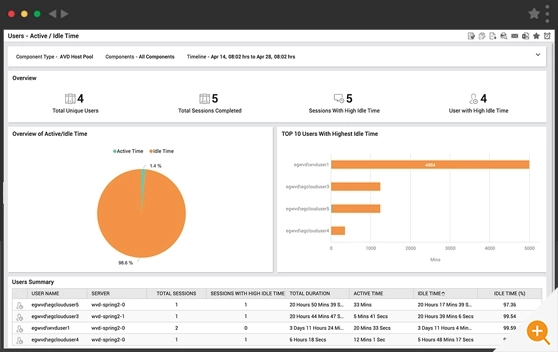
 Brian is a seasoned Technical Consultant based in California, currently lending his expertise to eG Innovations. With a rich background in digital workspaces, Brian has become a go-to professional for clients seeking top-tier solutions in AVD, Citrix, and VMware technologies. Brian's technical prowess is complemented by a profound understanding of user behavior and IT processes, making him an asset in creating seamless and user-friendly digital environments. Notably, Brian holds the prestigious title of an AWS Certified Cloud Practitioner, underlining his proficiency in cloud technologies.
Brian is a seasoned Technical Consultant based in California, currently lending his expertise to eG Innovations. With a rich background in digital workspaces, Brian has become a go-to professional for clients seeking top-tier solutions in AVD, Citrix, and VMware technologies. Brian's technical prowess is complemented by a profound understanding of user behavior and IT processes, making him an asset in creating seamless and user-friendly digital environments. Notably, Brian holds the prestigious title of an AWS Certified Cloud Practitioner, underlining his proficiency in cloud technologies. 




